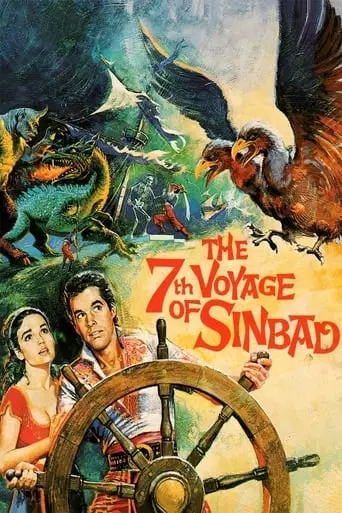
The 7th Voyage of Sinbad (1958) Watch Online Free
When a princess is shrunken by an evil wizard, Sinbad must undertake a quest to an island of monsters to cure her and prevent a war.
The 7th Voyage of Sinbad (1958) is a classic fantasy-adventure film that combines mythological elements with imaginative stop-motion animation. Directed by Nathan Juran and produced by Charles H. Schneer, it stars Kerwin Mathews as the legendary sailor Sinbad and Kathryn Grant as Princess Parisa. The film’s plot follows Sinbad as he embarks on a perilous journey to retrieve a magical item that can restore Princess Parisa to her normal size, after she has been shrunk by the evil sorcerer Sokurah. This takes him to the treacherous Island of Colossa, where he faces monstrous creatures, including a giant cyclops, a dragon, and a cobra-woman, all animated with the groundbreaking effects of Ray Harryhausen.
Sinbad’s quest begins when the sorcerer Sokurah, seeking to return to Baghdad, shrinks Princess Parisa as part of his dark magic. The only way to restore her is by obtaining a rare ingredient— the shell of a Roc’s egg, which is located on Colossa. With a crew of mutineers and loyal sailors, Sinbad sets off to find the egg. Along the way, they battle terrifying monsters and must outsmart Sokurah, who has ulterior motives of his own. The climax features a dramatic battle between Sinbad’s crew and the creatures of Colossa, leading to a victorious but bittersweet conclusion.
The themes of bravery, loyalty, and adventure run strong throughout The 7th Voyage of Sinbad. The film explores Sinbad’s courage as he faces impossible odds, navigating both physical and moral challenges. The character of Sokurah serves as a reminder of the corrupting power of ambition and greed, as his magical prowess is repeatedly used for selfish gains rather than noble causes. The film also explores the tension between reason and superstition, especially in the context of Sinbad’s reliance on both his sword and Sokurah’s magic to navigate the dangers of Colossa.
Additionally, the inclusion of mythical creatures such as the cyclops, dragon, and the cobra-woman allows the film to tap into the fascination with the fantastical that was prevalent in the 1950s. Harryhausen’s stop-motion animation was revolutionary at the time, and his creations are a central part of the film’s enduring legacy, contributing not just to its visual appeal but also to its thematic focus on the battle between man and monster.
The film’s use of stop-motion animation, under the direction of Ray Harryhausen, was groundbreaking. Harryhausen’s techniques influenced many films in the fantasy genre, and his work on The 7th Voyage of Sinbad set the standard for creature design and animation in later films. The monster battles, especially the confrontation between Sinbad and the skeleton, became iconic and were later replicated in Harryhausen’s other works, including Jason and the Argonauts (1963). The film’s influence is evident in the way it blended practical effects with fantasy storytelling, creating a model for later films like Clash of the Titans (1981).
After watching The 7th Voyage of Sinbad, viewers are likely to feel a sense of excitement and nostalgia. The blend of adventure and fantasy, enhanced by the magical realism of stop-motion creatures, provides a thrilling cinematic experience. The film’s adventure-filled narrative, with its trials and triumphs, offers a satisfying escape from reality, leaving viewers entertained and inspired. Fans of classic adventure tales will likely feel a renewed appreciation for the imaginative world that films like The 7th Voyage of Sinbad helped to create
In conclusion, The 7th Voyage of Sinbad is a cornerstone of fantasy cinema, combining mythical storytelling with innovative special effects. Whether you’re a fan of adventure, fantasy, or early visual effects, this film delivers on all fronts, making it a must-watch for any movie enthusiast.
